Researchers of Kyushu University, Japan have succeeded to reconstruct these gonadal somatic cells of the ovarian support system that is critical for the generation of mature egg cells. They were also able to apply their findings even to grow a viable organism.
"While we have been able to artificially make mouse oocytes from stem cells, for them to mature we had to combine them with supportive cells called gonadal somatic cells that were extracted from mice," explains first author Takashi Yoshino, assistant professor at the Faculty of Medical Sciences.
This new system is expected to provide a means of bioengineering a large number of oocytes without the need for harvesting the gonadal somatic cells from host animals.
How they developed this support system?
The major hurdle in the process is making the proper support system that helps differentiate stem cells into oocytes. The team followed a several step process:
Step:1 Genetic Analysis
The team's first step was to study mice and identify the critical genes and their production timing that gives rise to gonadal somatic cells.
Step:2 Culture Variantion
Following the identification, they meticulously tested mouse stem cells under differing culture conditions until they were able to produce cells with similar features.
They called them fetal ovarian somatic cell-like cells, or FOSLCs, since they have the same genetic expression profiles as gonadal somatic cells.
Step:3 Aggregation with oocyte precursors
The next step was to aggregate the FOSLCs with the stem-cell-derived primordial germ cells, the oocyte precursors.
After several days of growth, they were able to observe the cells beginning to form follicle structures surrounding the oocytes. Following confirmation that these cells were in fact fully grown oocytes, the eggs were fertilized and transferred into a surrogate mouse, successfully giving rise to offspring.
Applications:
"This will significantly help improve our understanding of ovarian follicle development and reproductive biology as a whole," explains Hayashi.
If we hope to better understand oocyte development and apply this technology to endangered animals and even humans, we must also be able to make the support system from stem cells.
The application on humans is technically feasible, but because of the genetic and epigenetic instability of in vitro made gametes, we still must carefully think and discuss the ethics and technology of its application. We will continue our work to further elucidate the mechanisms of this fundamental and unique extension of life.
References:
- Information provided by Kyushu University.
- Takashi Yoshino, Takahiro Suzuki, Go Nagamatsu, Haruka Yabukami, Mika Ikegaya, Mami Kishima, Haruka Kita, Takuya Imamura, Kinichi Nakashima, Ryuichi Nishinakamura, Makoto Tachibana, Miki Inoue, Yuichi Shima, Ken-ichirou Morohashi, Katsuhiko Hayashi. Generation of ovarian follicles from mouse pluripotent stem cells. Science, 2021; 373 (6552): eabe0237 DOI: 10.1126/science.abe0237





Nama : Adi Mulia
ReplyDeleteEmail : rekayasateknologi@uhamka.ac.id
Website : https://journal.uhamka.ac.id/index.php/rektek/index
Thankyou for nice information
Nama : Adi Mulia
ReplyDeleteEmail : adimulia@uhamka.ac.id
Website : https://uhamka.ac.id
Thankyou for nice information